Auntie Bernie stared across the room, pushed her glasses up on the bridge of her nose and slowly, menacingly, drew her thumb across her throat in a slitting gesture. “Don’t go there,” she hissed. “You’ll be slaughtered.”
Auntie Helen, a woman of few words but a voracious chilli sauce habit, nodded solemnly in agreement. Auntie Irene offered me no comfort and Auntie Gertrude shuffled her feet and stared at the floor.
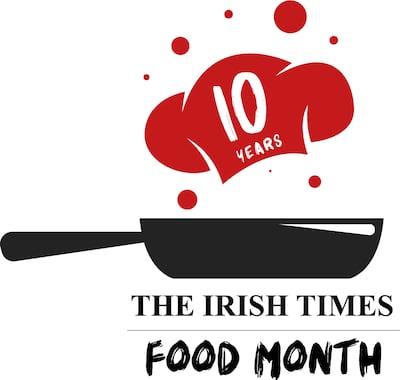
Even Uncle Charles, usually the most rambunctious of these Singaporean siblings, just repeated the throat-slitting motion on his own neck and whispered: “Yes, slaughtered.”
Auntie Bernie is 5ft tall in her bare feet and has just turned 71. I am a quarter of a century younger, a solid 25 per cent taller and, generally, just an awful lot larger. In Singapore it’s respectful to call anyone the generation above you either Auntie or Uncle. But these actually are my aunts and uncle, by marriage. And, not for the first time in the past 23 years with my in-laws, I have made a terrible mistake. To which I will return.
READ MORE
Our conversation, if it can be called that, is happening on August 9th, Singapore’s National Day. We are standing in the same compact apartment in Geylang in the south-east of the island that I first landed into with my then girlfriend, now wife, Deirdre, and her mother, Anne, the eldest of 10 Singaporean children, in 1999. When I nervously crossed this threshold at the age of 23 on my first trip to Asia, I was appalled by the size of my discarded shoes in the little shrine to footwear that exists outside every Singaporean home. Any passer-by would have concluded that a clown had come to dinner.
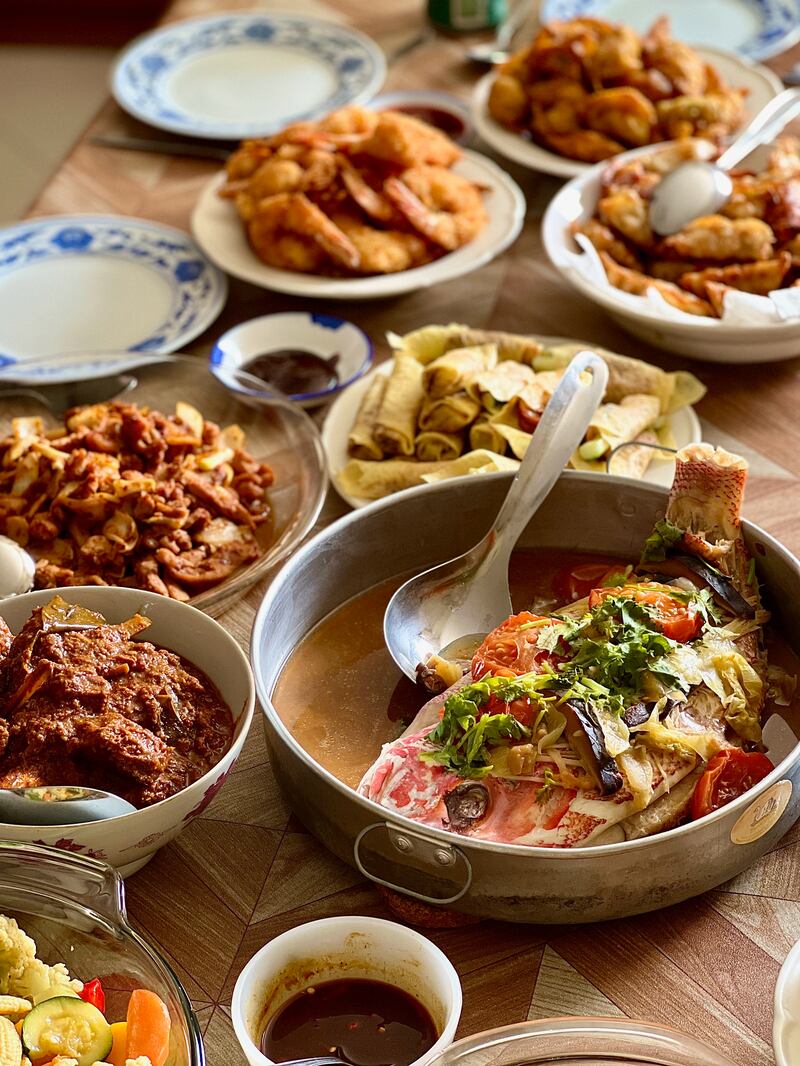
Back then, just as today, a couple of fans fought a hopeless battle against the equatorial heat. Today, in 2022, they are far more effective in transporting the aromas of ginger, garlic, candlenut, lemongrass, shrimp paste and coconut into the nostrils of the two dozen relatives and friends gathered.
Auntie Bernie has spent the morning directing operations in the small galley kitchen. A whole steamed red snapper in the Teochew style with salted Chinese plums, ginger and Shaoxing wine emerges. It’s followed by prawns sauteed in an unctuously rich chilli sauce and another heaving plate of even larger ones in the tempura style. There’s a dak galbi – a Korean spicy chicken stir-fry - and a bulgogi, which translates as “fire meat”, with thin slices of beef flash-fried with garlic, gochujang and mixed peppers.
Family members have spent the morning hand-folding dozens of pork and prawn wontons for deep-frying and serving with a punchy sweet chilli sauce. A similar amount of tiny Peking duck pancakes have been individually assembled. All good cooks make their craft look easy but few make it seem as effortless as Bernie. She’s done it so often she almost appears bored as she delivers dish after enticing dish.
The creation that excites me most is one I’ve seen several times before. Uncle Michael’s famous beef shin rendang will take pride of place alongside the whole steamed Teochew snapper. This rendang is obscenely good. There’s spice, sure, but it yields to a rich coconut sauce with back notes of the distinctive Malay shrimp paste and lemongrass and galangal.
It’s the fragrancy that shines through though. It’s so floral you look around the room for tulips. Uncle Michael says the lime leaves are key. His rendang manages to be both exotic and homely at the same time.
But back to my terrible mistake. With a belly full of rendang, moist and flaky snapper, crunchy wontons, bulgogi and dak galbi, I have committed a crime against Singaporean sensibilities. In a discussion about our next significant meal out, I have suggested paying more than I need to for some of the best food in the world. There are two things that particularly exercise all Singaporeans. The first, obviously and without exception, is food. The second is how much things - usually food - cost.
To be “slaughtered” on this small and diverse city-state island of 5.5 million people does not suggest death or physical violence – it’s one of the safest and most crime-free places on the planet. Slaughtered in this case means to be ripped off. And because I’m an idiotic giant ang moh with no appreciation of money or value, the stall operators in the famous Newton hawker centre will “see me coming” and hike their prices accordingly - sometimes by as much as 10 per cent. That could add three or even four dollars to our meal. Three Singaporean dollars is approximately two euro.
“Newton is for tourists,” decreed Auntie Bernie. “And even more expensive since the movie Crazy Rich Asians was shot there. We go to East Coast Lagoon instead.” East Coast Lagoon and Newton are two of approximately 120 hawker centres in Singapore. They all have speciality food stalls ranging in number from about 50 to, in the case of the largest, 700 spread around common seating areas.
They are, and I write this having spent vast sums eating out in a wide variety of countries, the greatest, most aromatic, most intoxicating and jaw-droppingly best value food experiences you will ever have. If I’m ever offered a last meal, my response will be instant: “Stick me at one of those formica-topped hawker centre tables with a backless stool and an unforgiving fluorescent light. Bring me an ice bucket full of large Tiger beers and start serving from the stalls in random order.”
Singapore is a young country. It celebrated its 57th birthday on the most recent National Day. Its progress even in the two decades since I first visited has been staggering. That this tiny island nation - just off the southern tip of peninsular Malaysia and within 20km of Indonesia and its population of 285 million - even exists is surprising enough. That it has carved out a hugely prosperous, diverse and multi-cultural reality in the shadow of these two much larger neighbours is nothing short of an Asian miracle.
Lee Kuan-Yew, widely recognised as the father of the nation, opined that it was the invention of air-conditioning that allowed Singapore to develop and prosper. But it is no exaggeration to declare that food is the cultural glue that holds Singaporeans together. At times it seems they talk or think about little else.
This is the Premier League of food, a bubbling hotpot of the best culinary traditions of south and south-east Asia serving up their very best traditional incarnations but also sparking off each other and, regularly, producing new and hybrid dishes. It’s also where high-end chefs from all over the world come and attempt to make the grade in a location with impeccably high standards and expectations.
The city now has 52 Michelin-starred restaurants. Mayo’s Andrew Walsh is the chef-owner of one of these, Cure, and serves up an Irish heritage-themed menu including a dish called Childhood Memories of Peat. Cure, situated in a dark and cosy room in the buzzing Chinatown district of the city, is excellent, fun and endlessly inventive.
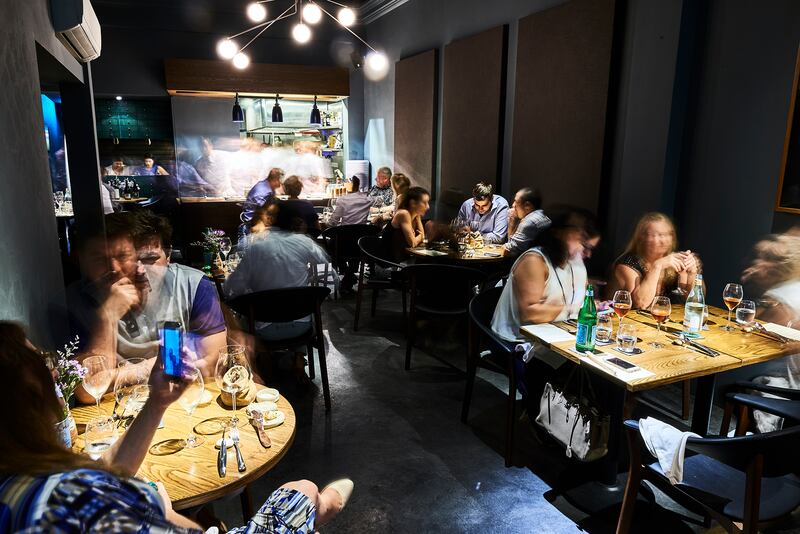
Ten minutes across town in Dempsey Hill, Australian chef Dave Pynt also has a Michelin star and a brick oven that heats to more than 1,700 degrees in his Burnt Ends outlet. His modern barbecue restaurant, a temple of smoke and meat, is considered one of the best in the world. All over town there are decorated chefs from Italy, France, the Basque country, Japan, Korea and multiple Chinese provinces all knocking it out of the park.
They have to be on top of their game because this is also where there are Michelin-starred chefs like It Tang Chay Seng. He runs Hill Street Tai Hwa Pork Noodle, where you can pick up a bowl of bak chor mee – a traditional Teochew vinegary, minced pork and soupy dish with a multitude of toppings – for €4.50, or €7 if you’re feeling hungry and want a big bowl. This is probably the cheapest Michelin star meal you’ll ever eat.
Not that my Singaporean in-laws are impressed by mere accolades. When, some years back, another hawker centre stall won a Michelin star for its similarly priced dish of Hainanese chicken rice, the extended Lee family ended up having a four-day argument about whether it really was the best version around.
Chicken rice, along with chilli crab, has a strong claim to be Singapore’s national dish. Simple in concept, brilliant in execution, it is poached chicken served with rice, sliced cucumber and a fiery chilli sauce on the side. The chicken, with a little sauce and sesame oil, is almost incidental because rice is the star. Cooked in chicken stock with an aromatic mix of ginger, garlic and spring onions, it’s the comfort food of the gods.
And so here we are at East Coast Lagoon hawker centre. The rules, for me, are simple and have been honed over the years. I’m allowed to wander and marvel at the sights, smells and energy of the impeccably clean set-up. When I return to the common table, I mention things I fancy and a bevy of eager Singaporeans, determined to look after a guest they consider to be irredeemably naive, will fan out to order and, sometimes, collect.
The food starts arriving within minutes. First up is a speciality omelette, orh jian, which is salty, slightly crispy and heaving with freshly fried oysters served alongside a powerful chilli sauce. Then comes the classic Hokkien prawn mee, a noodle dish fried with egg, pork, prawn and squid served with limes and sambal chilli. Dozens of sticks of satay, chicken, pork and mutton arrive from one of the smoky barbecue pits and are fallen upon by the children who roll them, and ketupat rice cakes, in a viscous peanut sauce.
They’re quickly followed by massive juicy and marinated barbecued chicken wings on a bed of, well, greaseproof paper. There’s Chai tow kway, which everyone calls fried carrot cake although there’s no carrot in it. It’s a mistranslation and it is, in fact, a steamed and then fried daikon radish cake with preserved turnip, diced garlic, eggs and fish sauce.
The hits keep coming out of the salty seaside night air. A huge portion of barbecued stingray is presented. It’s wrapped in a banana leaf which you peel back to unveil a piping hot and flaky white fish completely smothered in sambal. You just pick firm and luscious chunks off it with chopsticks.
And then the mother ship lands. An immense foil tray filled with a mud crab and swimming in the now famous chilli, tomato and garlic sauce. A full portion of mantou comes alongside. These are fluffy bread buns that have been fried. They are for scooping up the crab and sauce that remains after the crustacean has been dispatched.
You’ll never forget your first chilli crab. It’s impossible until after your clothes return from the dry cleaners, anyway. But the food of Singapore will endure in your mind and taste buds long after those stains have finally been expunged.
RECIPE: UNCLE MICHAEL’S FAMOUS BEEF RENDANG
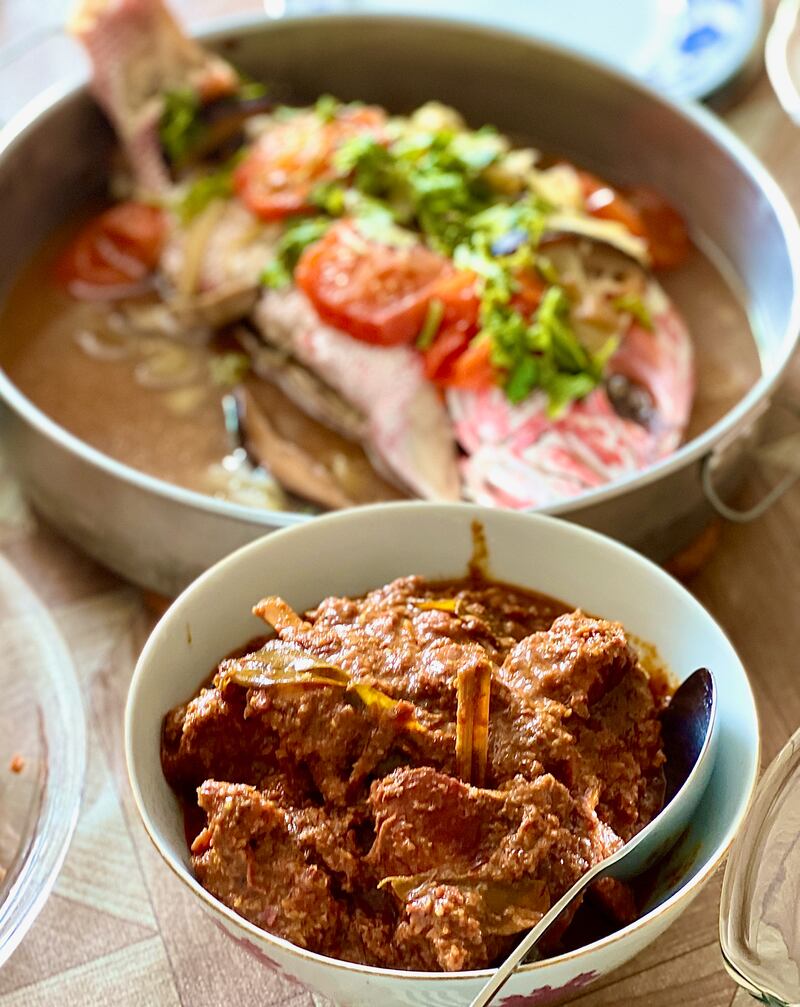
Uncle Michael is Singaporean and may be able to handle more chilli than some Irish people. I have eaten this rendang many times and don’t find it overly hot. Also, he says that you’re not allowed to reduce the chilli. Belachan (shrimp paste) and palm sugar (gula melaka) are available in speciality shops in Ireland and online for delivery.
For the rempah (spice paste):
50g dried chilli
100g onion
50g garlic
30g galangal
3 lemongrass stalks
Fresh turmeric (2 finger size pieces)
50g dried belachan (shrimp paste)
30g candlenut
For the beef:
1kg beef shin (any beef is acceptable, but shin is ideal for a slow cook rendang. Also, it’s cheaper than other cuts).
8 lime leaves
3 tbsp curry powder
3 lemongrass stalks
2 pieces gula melaka (palm sugar)
2 cups coconut milk (concentrated)
2 tbsp sugar
1 tsp salt
For the marinade:
1 cup of old ginger juice (I asked Uncle Michael what “old ginger juice” was. He replied: “It’s juice from old ginger.” So now you know. Don’t tell him, but if you can’t source enough old ginger juice I don’t believe the marination is key for this dish.)
To finish:
1 cup of freshly grated coconut flesh.
Method
1 Cut the beef shin into one-inch pieces and soak in the ginger juice for at least 30 minutes, before draining in a colander.
2 Fry the cup of grated coconut flesh until dry and slightly brownish. Set aside.
3 Blend the rempah ingredients into a paste and fry in oil until golden brown, set aside.
4 Fry the beef in oil and add the rempah and curry powder.
5 Add lime leaves, lemon grass stalks, palm sugar and sugar.
6 Add coconut milk, bring to boil, reduce to simmer for 2-3 hours, or until the beef is tender.
7 Add salt to taste.
8 Add fried grated coconut before serving.
9 Serve with rice or a warm baguette (Singaporeans love baguettes) and a side of Malaysian roasted cauliflower or stir-fried vegetables.
Note: The rendang should emerge as a deep brown/red colour. You can add a couple of tablespoons of dark soy sauce to achieve this if you feel it is too pale. And you’re not looking for a very saucy curry here. Uncle Michael’s rendang is moist but viscous. It’s a fairly dry curry. So don’t be afraid to cook down the coconut milk.

FIVE IN-LAW RECOMMENDED HAWKER CENTRES TO TRY IN SINGAPORE
Chomp Chomp Food Centre, Kensington Park Road
ABC Brickworks Hawker, Jalan Bukit Merah
Newton Food Centre, Newton
East Coast Lagoon Food Village, East Coast Park
Old Airport Road Food Centre, Old Airport Road
FIVE MUST-EAT DISHES
Roti Prata
Eat at any time of the day but especially at breakfast. This is a South Indian flatbread made by constantly flipping a blend of dough and ghee into a thin layer before frying and serving fresh and hot alongside a bowl of curry (vegetable or fish). There is no better breakfast, anywhere.
Curry Puff
Probably Singapore’s favourite snack food. Resembling an empanada, these are delicious deep fried pies filled with curried chicken and potatoes in a puff pastry shell. Singaporeans will almost come to blows arguing over their favourite stalls and the consistency of the curry and flakiness of the shell. Available everywhere.
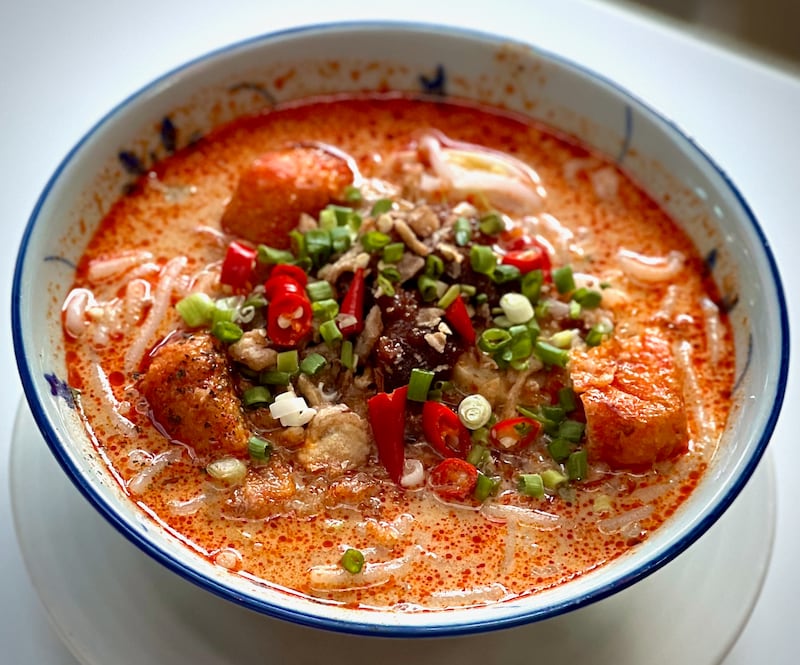
Laksa
The third of the holy trinity, along with chicken rice and chilli crab, of Singaporean food. Originating from Peranakan cuisine this is a very rich and spicy coconut-based soup with noodles and topped with fish, chicken or cockles. Try 328 Katong Laksa on East Coast Road. It, easily, defeated Gordon Ramsay in a street food challenge some years ago.
Sambal Chilli Lala
These are sambal clams and they are, in my view, an under-celebrated star of a dish in Singapore. The sweet and briny clams are wok fried with pungent shrimp paste, chillies and spices. They are widely available and massively addictive.
Black Pepper Crab
Anyone who has spent any time in Singapore has a very common response if they hear someone extolling the national dish of chilli crab. “The black pepper crab is even better,” they’ll say. And, whisper it quietly, they’re probably right. Sticky and glazy and absolutely pumping with spicy pepper flavour. It’s incredible.
















